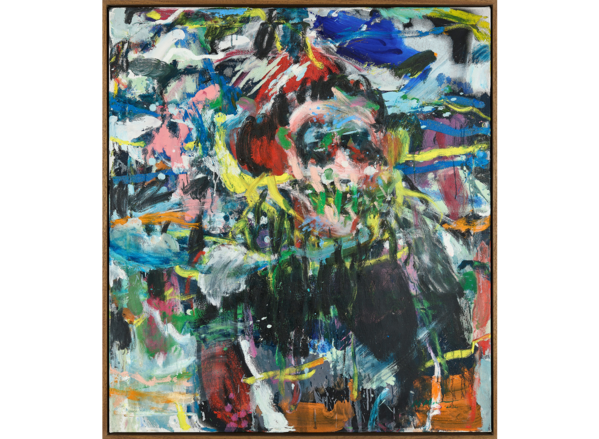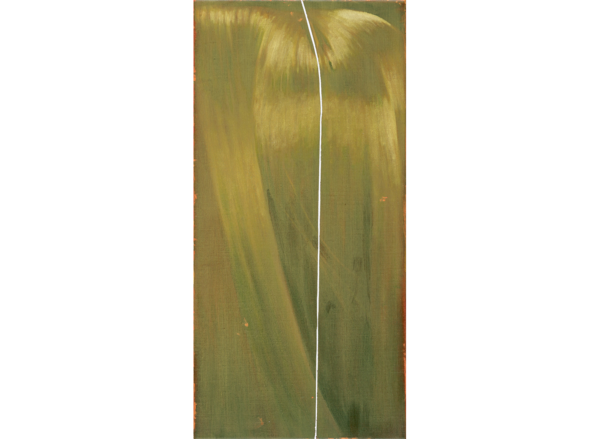Lindsey Mendick, Every part of me, 2022. Whitechapel Gallery Art Icon Charity Auction.
Phillips is proud to partner with Whitechapel Gallery for its annual Art Icon gala,which this year honors the work of renowned British artist Tracey Emin. Coinciding with the gala is an online auction hosted by Phillips which features artworks and experiences donated by contemporary artists which will be sold to benefit Whitechapel Gallery's pioneering Education Programs. We spoke with three featured artists on their contributions, inspirations, and what Tracey Emin's work means to them.
PHILLIPS: Tell us about your work which is part of the Whitechapel Gallery Art Icon charity auction.
MISHECK MASAMVU: My focus in painting has been to understand my grammar. I believe I have created an alphabet that has helped me paint and speak my truth – I have rediscovered non-conformity in the approach to what painting might be. As my work oscillates between abstraction and figuration, it is neither one thing nor the other; the images exist in the in between or the unknown. For me, I see Twitching Bulb as:
It is a turn off,
It is a posture of ideals and standards,
It is a disconnection of two points.
It is a failed dialogue,
It is a birthday celebrated alone.
LOUISE GIOVANELLI: These pieces do not denote real people. They are not individuals. Using wigs helped accentuate this feeling of anonymity. Equator comes from medieval Latin aequator, or aequare, meaning 'make equal’ - in the phrase ‘circulus aequator diei et noctis’ - circle equalizing day into night. I’ve been thinking about hair and the central parting as being an equalizing aesthetic force. It mirrors the opposing hemispheres of the brain - which work together towards balance and equilibrium. I think organizing a painting works the same way. I’m interested in these micro/macro relationships. But also in a very straightforward formal way, I wanted to paint the shape of a head with light reflecting off the hair. I’m drawn to the sculptural quality of things/objects and how they are interesting only because of light hitting them and what that light reveals.
LINDSEY MENDICK: Every piece of me is part of a series of ceramic vases that are both autobiographical and highly personal. I imagine the vases being very stable entities, rooted in ceramic history, and my additions to them, are the life and decay seeping in. With tentacles, slugs and miniature organs, I defile the purity of them, leaving them leaky and ravaged.
P: How do you see Tracey Emin’s influence from the perspective of young and emerging artists today and has she impacted your practice?
LG: The trait I respect most of Tracey’s is her steadfast determinism. The unapologetic revealing of herself through the art piece - although different from my work, reveals a sense of commitment and confidence that resonates with me. I think through this comes an authenticity that i feel is crucial and is likely one of the reasons she is considered such a significant contemporary figure.
LM: Tracey inspired a great deal of artists to be defiant and to make art directly from their soul. From a young age, her work conveyed to me that there was space for people like me in art to express themselves on their terms… people who found life difficult and felt like an outsider. She inspired me to be honest and passionate… if it doesn’t come from the heart, if it’s not honest, it’s not enough.
MM: I have only had the opportunity to see Emin's work a handful of times, but her approach to mark making and the gestural abstraction resonates with me. I appreciate how there is this flirtation between figuration and abstraction within her images. It breaks away from convention, establishing its own pictorial language which bleeds with honesty when thinking about the psyche. This is most evident in her drawings.

Misheck Masamvu, Twitching Bulb, 2022. Whitechapel Gallery Art Icon Charity Auction.
P: What does social engagement mean within your work? How does your art express its impact to the world?
LM: Social engagement is so important to my work. As well as creating work that I feel is directly for the viewer, and explores the darker side of mental health, I am also invested in creating opportunities for others. In 2021 myself and my partner Guy Oliver opened a gallery in the pandemic. We wanted to give artists and curators an opportunity to develop new work and put on exhibitions in Margate during a difficult time. Our main aim was to pay artists to put on small shows. And in 2021, by selling my editions and through arts council money, we paid over £35,000 to artists and creatives who helped to run the space. In addition to this, quench takes 0% commission if an artist sells a work. This doesn’t make us saintly though. Far from it. I feel awful about most things most of the time. But I think that when artists do start doing better, it is important to give back If you can!
MM: I see my works as 'creepers' and 'mutants' – the figure and the landscape are constantly moving and changing within the environment. It is as if they are feeding off each other, slowly changing one another. As you may know, much of my work focuses on the battle against the forced ideology of government or authority and the breakdown of the pursuit of humanity, so it is my hope that my art offers a space for constant self-reflection and the call for metamorphosis. Within the layered surfaces, abstracted forms and brushstrokes of my work, I want the viewer to find an alternative space which allows for the beginning of a new consciousness or rebirth within them.

Louise Giovanelli, Equator, 2022. Whitechapel Gallery Art Icon Charity Auction.
P: How do you engage with historical or previously existing modes of art in order to create new concepts?
LG: I often make specific journeys to see Old Master works in situ. During these encounters, a previously overlooked detail in a painting can become the subject of a new work. When I engage with these works, I suppose i am searching for religious and universal human themes. I then assimilate parallel moments from contemporary life - through images of pop stars, television, and film stills. However, much of the time my engagement with previously existing modes of art is not symbolic but material. I will study how a painting has been made or an effect achieved rather than what is being depicted. For example, my use of light derives from this kind of approach, appearing to emanate from the canvas depths, achieved through the application of thin layers of highly pigmented paint, itself a traditional technique. I am drawn to these traditional techniques because they were based on the core principles of light. The physicality of the light in the room, the light emanating from the primed canvas, and how this interacts with pigments.
P: What’s ahead for you this year?
MM: There are many projects in the pipeline, but my major focus for 2022 is my participation in the 5th edition of the Aichi Triennale, titled STILL ALIVE, which opens in late July 2022 (curated by Mami Kataoka).
LG: I'm excited to open my first show with White Cube in their Bermondsey space, opening 5th July.
LM: This year I’m working on my first solo show with Carl Freedman Gallery and also creating a new installation as part of the Hayward Gallery’s clay show. It feels a bit like a very good dream, actually.
Discover More from Whitechapel Gallery Art Icon Charity Auction >
Recommended Reading
